Scania DI13 XPI. Marine engine en-GB 2 818 093. Operator’s manual - part 5
Cooling system
3. Fill the cooling system with clean hot water
mixed with detergent 2 479 017. Detergent
2 479 017 must make up 5-10% (depending
on the degree of dirt) of the total coolant vol-
ume.
If detergent 2 479 017 is not available, use a
dishwasher detergent for household dish-
washers that does not foam. Concentration
1%.
4. Run the engine until it has reached operating
temperature for approximately 20-30 min-
utes. Remember to switch on the cab heating
system, if one is installed.
5. Drain the cooling system.
6. Fill the cooling system with clean, hot water
and run the engine for about 20-30 minutes.
7. Repeat steps 3-6 if the cooling system is not
clean.
8. Drain the water from the cooling system.
9. If necessary, clean the expansion tank by de-
taching all hoses and rinsing and cleaning
with a degreasing agent and a dishwashing
brush.
Alternatively, dismantle the expansion tank
and clean it with water with 10% of detergent
2 479 017. Fill the expansion tank with the
mixture, shake it and drain it. Renew the cov-
er of the expansion tank.
10. Fit a new thermostat.
11. Fill the cooling system with new coolant as
described in the next section.
12. Check again whether further dirt or oil has
collected in the expansion tank. Decide
whether it it is necessary to carry out another
full cleaning or whether only rinsing or
cleaning of the expansion tank will suffice.
64
Cooling system
Internal cleaning: Removing deposits
in the cooling system
Environment
Use a suitable container. Used coolant must be
disposed of as specified in national and interna-
tional laws and regulations.
1. Run the engine until it has reached operating
temperature and then drain the cooling sys-
tem following the previous description.
2. Remove the thermostat.
3. Fill the cooling system with clean, hot water
mixed with radiator detergent which is based
on sulphamic acid and contains dispersing
agents. Follow the manufacturer's instruc-
tions for the concentration and cleaning peri-
od.
4. Run the engine for the specified time. Re-
member to switch on the cab heating system,
if one is installed.
5. Drain the cooling system.
6. Fill the cooling system with clean, hot water
and run the engine for about 20-30 minutes.
7. Drain the water from the cooling system.
8. Reinstall the thermostat.
9. Fill the cooling system with new coolant as
described in the next section.
65
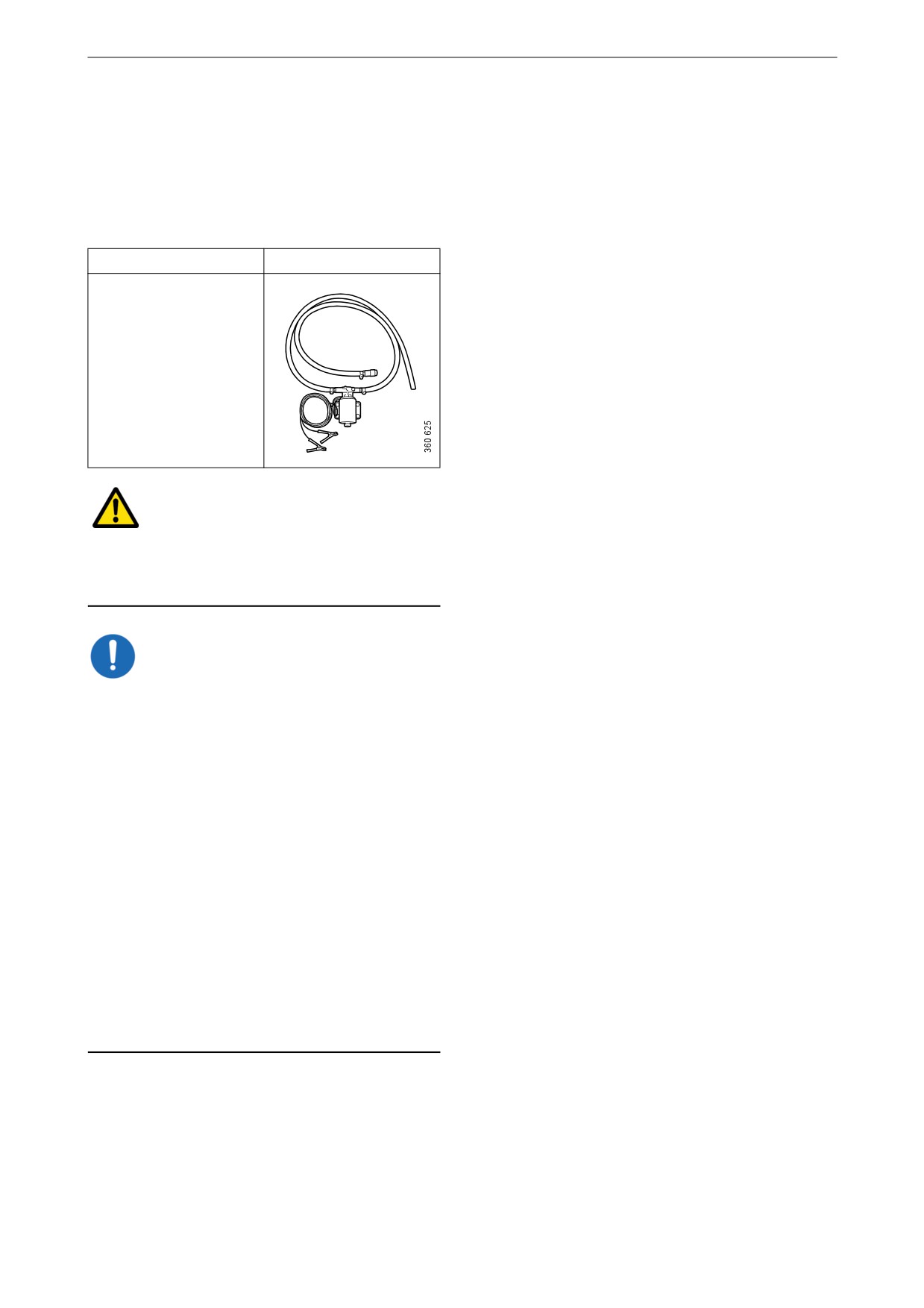
Cooling system
Filling coolant
This procedure applies when the cooling system
has been drained and needs to be filled with a
large amount of coolant.
Special tool
Number, designation
Illustration
2 443 679, coolant
pump
WARNING!
Use protective gloves as coolant can cause irrita-
tion if it comes in contact with the skin. Hot cool-
ant can also cause scalding.
IMPORTANT!
Mix the coolant as specified in the section head-
ed Coolant.
It is not permissible to top up large amounts of
coolant via the expansion tank. Filling via the ex-
pansion tank leads to air locks in the cooling sys-
tem which can lead to e.g. damage to the coolant
pump shaft seal. If a large amount of coolant
needs to be added, follow the instructions in the
section Filling coolant.
Never fill a large amount of cold coolant in a hot
engine. There is great risk of cracks forming in
the cylinder block and cylinder heads.
Do not start the engine until the correct coolant
level has been obtained. If the engine is started
with an insufficient coolant level, it can damage
the coolant pump shaft seal, which leads to cool-
ant leakage.
66
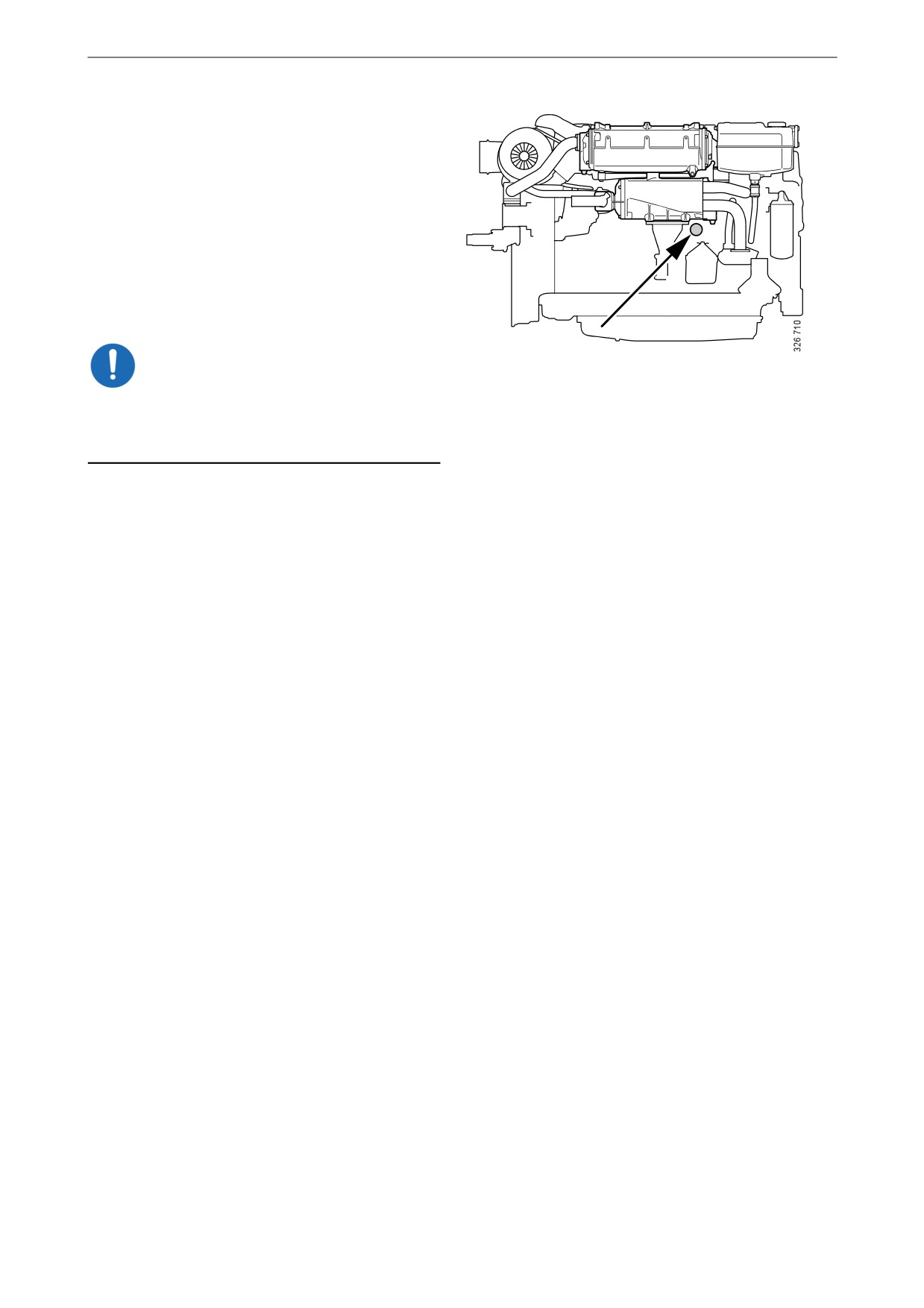
Cooling system
1. Open the expansion tank cap.
2. Connect the coolant pump to the filler nipple
in the cylinder block.
3. Connect the pump’s two cable terminals to
the battery’s negative and positive terminals.
Make sure that the filling starts. If the filling
does not start: Change the position of the ca-
ble terminals.
4. Start the engine and run it at idling for
15 minutes.
IMPORTANT!
Filler nipple in the cylinder block.
It is very important that the engine is idling. En-
gine overspeed could damage the coolant pump
shaft seal, which leads to coolant leakage.
5. Switch off the engine and fill with coolant to
the maximum level through the expansion
tank.
Air pockets may still be left in the cooling
system. These will disappear after the engine
has been operated for a period of time.
Therefore, the coolant may need topping up
at a later stage.
Finishing operations
1. Open the bottom valve on the sea water inlet.
2. Start the engine and check that no leakage
occurs.
3. Check the coolant level and top up the cool-
ant via the expansion tank if necessary.
67
Fuel system
Fuel system
Cleanliness requirements
IMPORTANT!
The whole fuel system is very sensitive to dirt
and even very small particles. Foreign particles
in the system can cause serious malfunctions. It
is therefore very important that everything is as
clean as possible when work is carried out on the
fuel system. Before repair work, the engine must
be washed. If possible, a hot water wash should
be used.
It is strictly forbidden to carry out any machining
work or work with compressed air near an open
fuel system.
Be extra careful and always use clean, lint-free
and dust-free clothes and disposable gloves
when working on the fuel system. Scania recom-
mends using Tegera 848 gloves.
Clean tools before they are used and do not use
any worn or chrome-plated tools. Material and
flakes of chrome may come off.
Clean connections and the surrounding area be-
fore removal. When cleaning, cloths or paper
which shed fibres must not be used. Use clean
and lint free cloths, part number 588 879.
Plug or cover the connections during removal.
Also clean the connections before the compo-
nents are fitted. Place removed components on a
thoroughly cleaned, dust-free surface. Scania
recommends using a stainless steel bench top,
part number 2 403 296. Cover the components
with a lint free cloth.
68
Fuel system
Checking the fuel level
Check the fuel level and top up with fuel as nec-
essary.
Note:
If the fuel tank has been run dry or if the engine
has not been used for a long time, bleed the fuel
system. See the section Bleeding the fuel system.
69

Fuel system
Renewing the fuel filter
Environment
Use a suitable container. The fuel collected must
be disposed of as specified in national and inter-
national laws and regulations.
1. Clean the exterior of the fuel filter with a
damp cloth.
2. Unscrew the filter.
3. Apply oil to the gasket on the new filter.
4. Screw the filter into place by hand until it
makes contact.
5. Screw a further half turn by hand.
6. Bleed the fuel system according to the in-
structions in the Bleeding the fuel system
section.
Fuel filter location.
70
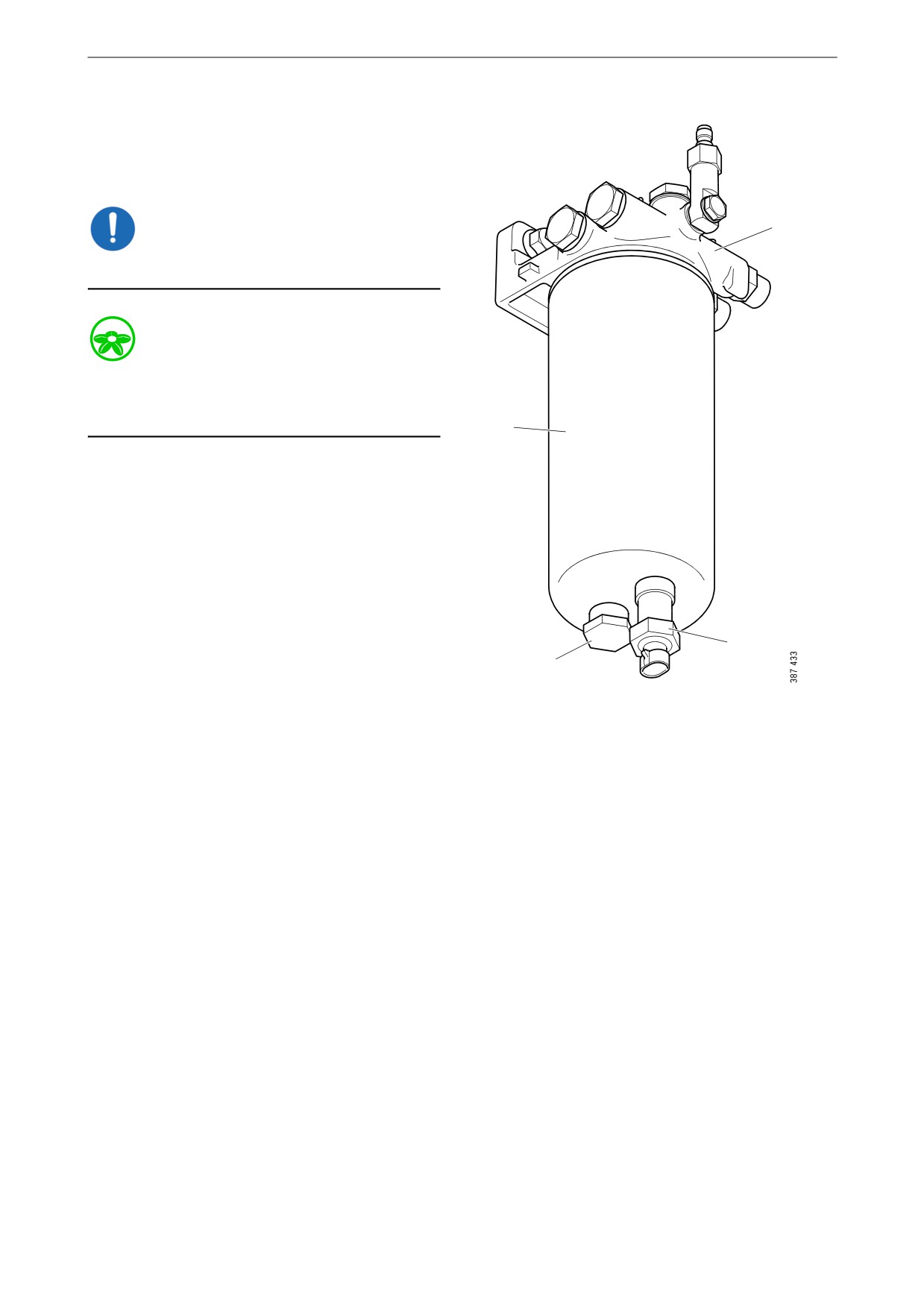
Fuel system
Draining and renewing an en-
gine-mounted water separat-
ing prefilter
IMPORTANT!
1
The sensor cable is sensitive. Handle it carefully.
Environment
Use a suitable container. The fuel collected must
be disposed of as specified in national and inter-
national laws and regulations.
2
1. Close the shut-off cock in the fuel pipe and
position a container under the filter.
2. Detach the sensor cables from the contact
housings on the filters.
3. Open the filter drain plugs and allow the flu-
id to run down into the container.
4. Unscrew the filters (3) from the filter head
(4).
5. Discard the old filters and use new ones.
3
4
6. Lubricate the O-rings on the filters with en-
gine oil.
Engine-mounted water separating prefilter.
7. Fill the width of the filters with clean fuel.
8. Screw the filters into position until the O-
1. Filter head
rings rest against the filter head.
2. Filter
3. Contact housing
9. Tighten the filters by hand a further half-
turn.
4. Drain plug
10. Open the shut-off cock in the fuel pipe and
check that the fuel system is sealed.
11. Connect the sensor cable to the contact hous-
ings on the filters.
12. Bleed the fuel system according to the in-
structions in the Bleeding the fuel system
section.
71
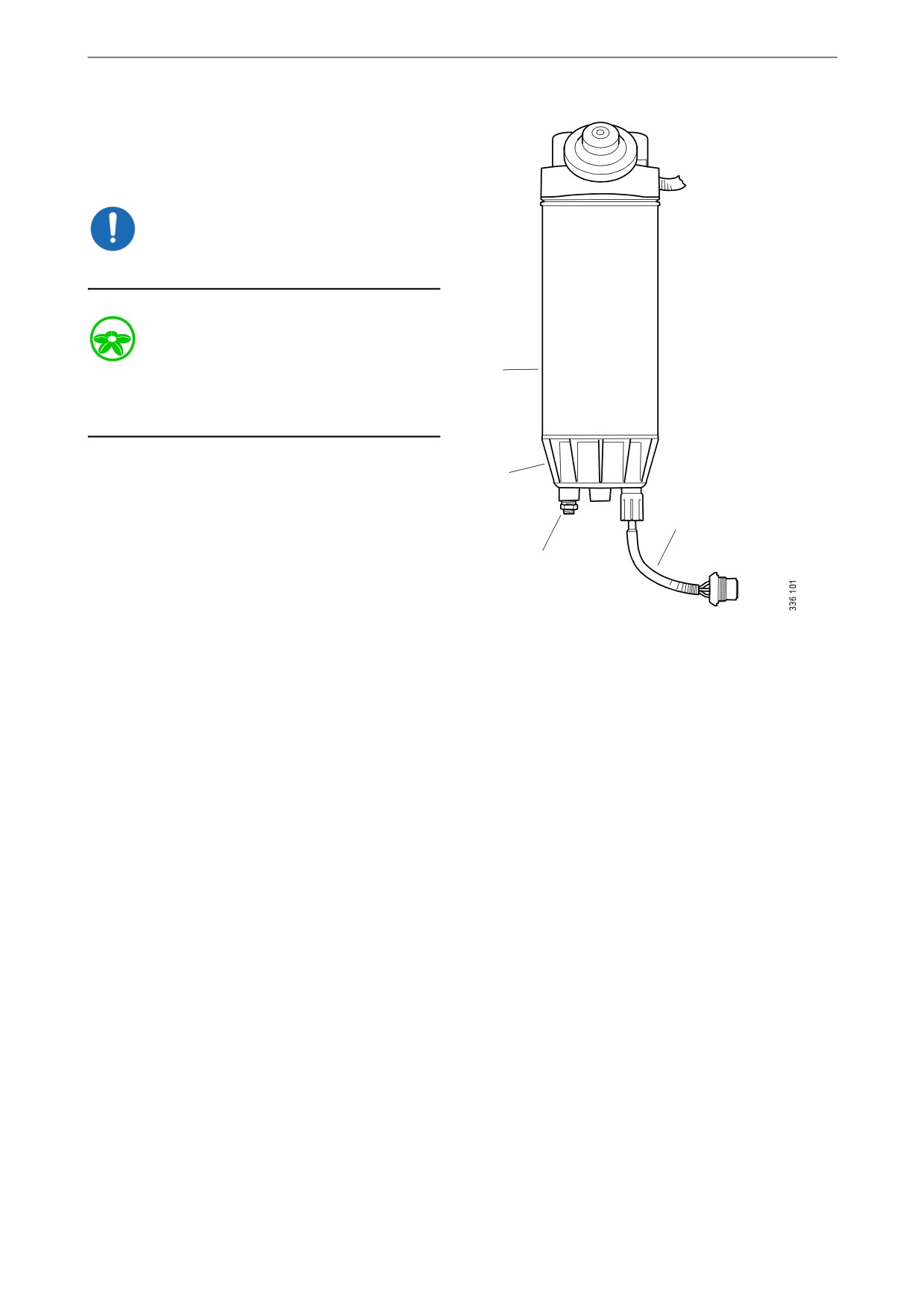
Fuel system
Draining and renewing the
single water separating prefil-
ter (option)
IMPORTANT!
The sensor cable is sensitive. Handle it carefully.
Environment
4
Use a suitable container. The fuel collected must
be disposed of as specified in national and inter-
national laws and regulations.
Before starting work: Close the shut-off cock in
3
the fuel pipe and position a container under the
filter.
1
1. Undo the sensor cable from the connector on
the filter bracket.
2
2. Open the drain tap in the filter cover and let
the fluid run down into the container.
3. Unscrew the filter cover.
1.
Sensor cable
4. Unscrew the filter from the filter head.
2.
Drain tap
5. Discard the old filter and use a new filter.
3.
Filter cover
6. Lubricate the O-ring in the filter cover with
4.
Filter
engine oil.
7. Screw the filter cover onto the new filter by
hand. Make sure that the drain tap is fully
closed.
8. Lubricate the O-ring on the filter with engine
oil.
9. Fill the width of the filter with clean fuel.
10. Screw the filter into position until the O-ring
rests against the filter head. Tighten the filter
another 1/2 to 3/4 turn by hand.
11. Open the shut-off cock in the fuel pipe and
check that the fuel system is sealed.
12. Screw the sensor cable in the contact housing
onto the filter bracket.
13. Bleed the fuel system according to the in-
structions in the Bleeding the fuel system
section.
72
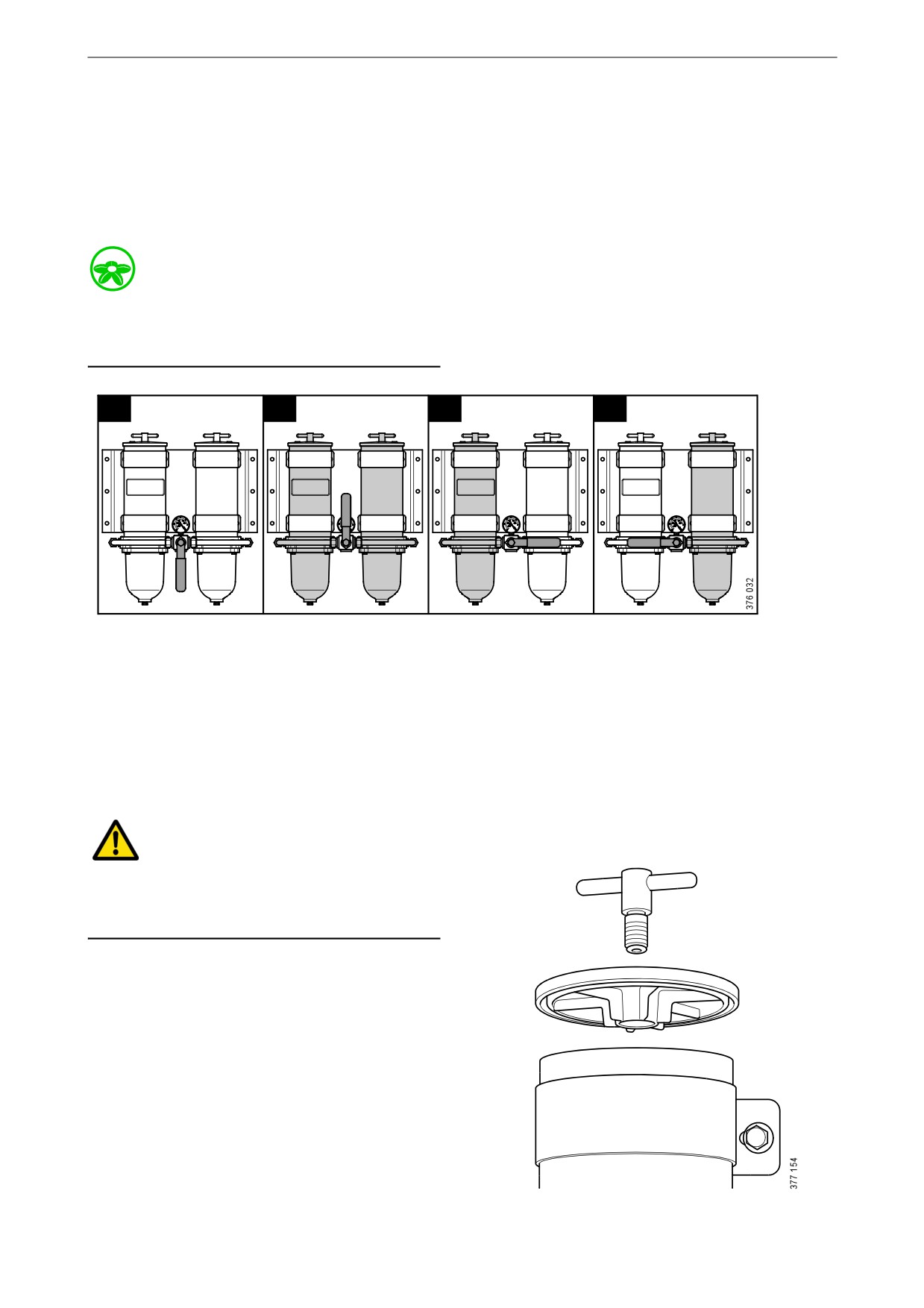
Fuel system
Draining the commutative wa-
ter separating prefilter (op-
tion)
During operation, the arrow on the rotary control
should point towards the filter being used.
Environment
Use a suitable container. The fuel collected must
be disposed of as specified in national and inter-
national laws and regulations.
1
2
3
4
1. Closed; neither filter is active
2. Both filters are active
3. Left-hand filter is active
4. Right-hand filter is active
1. Switch off the filter that needs renewing. The
arrow on the rotary control points towards
the filter in operation.
WARNING!
Be careful that the valve does not pass the closed
position when the engine is in operation. A
closed position can result in the engine stopping.
2. Remove the cover from the filter housing.
73
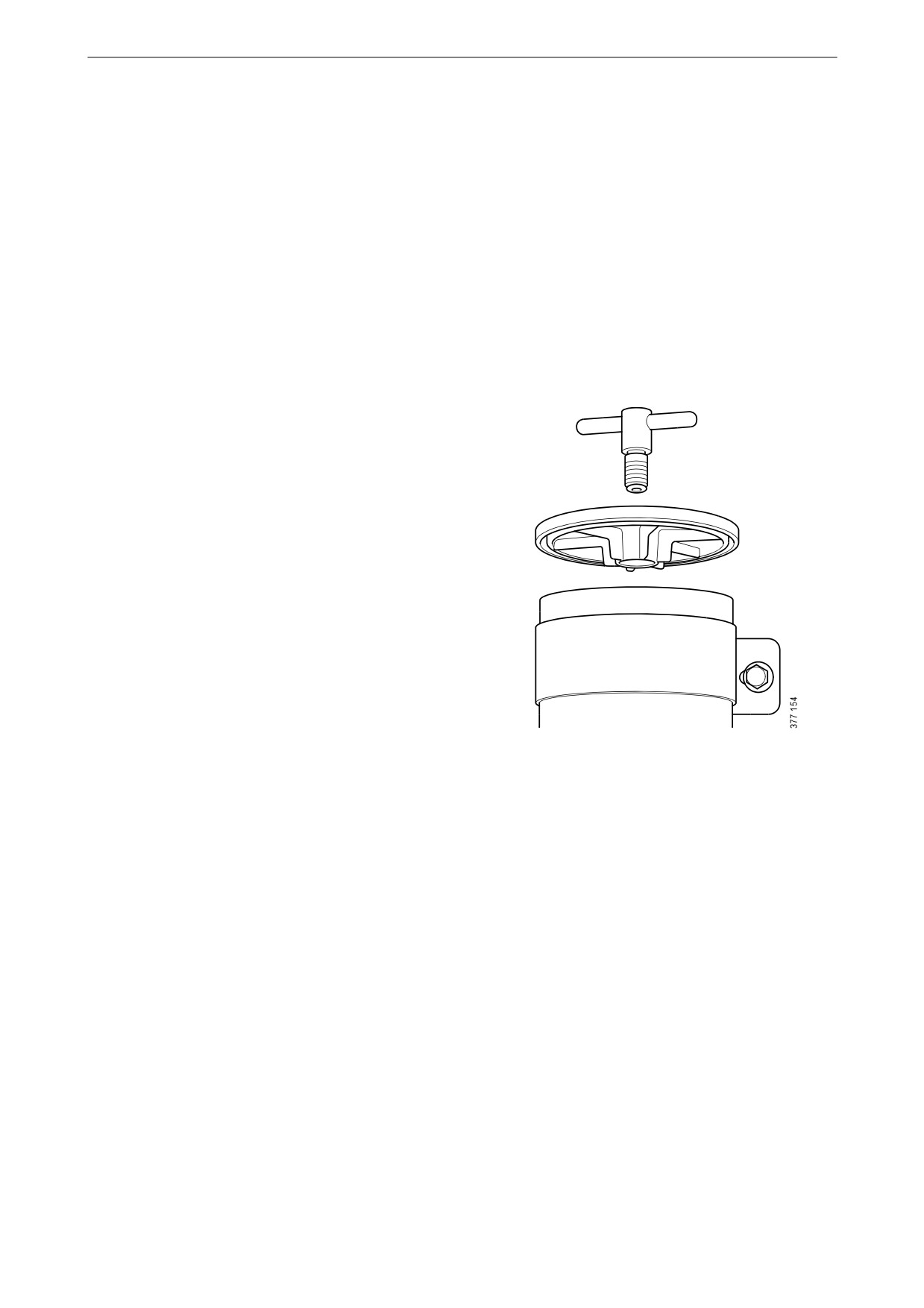
Fuel system
3. Undo the drain plug.
4. Tighten the drain plug when all the water has
emptied.
5. Fill the filter housing with clean fuel.
6. Fit the cover. Tighten the cover screw by
hand.
74

Fuel system
Renewing the commutative
water separating prefilter (op-
tion)
During operation, the arrow on the rotary control
should point towards the filter being used.
Environment
Use a suitable container. The fuel collected must
be disposed of as specified in national and inter-
national laws and regulations.
1. Switch off the filter that needs renewing.
During renewal, the arrow on the rotary con-
trol points towards the filter in operation.
WARNING!
Be careful that the valve does not pass the closed
position when the engine is in operation. A
closed position can result in the engine stopping.
2. Clean the filter housing externally with a
cloth.
3. Remove the cover from the filter housing.
75
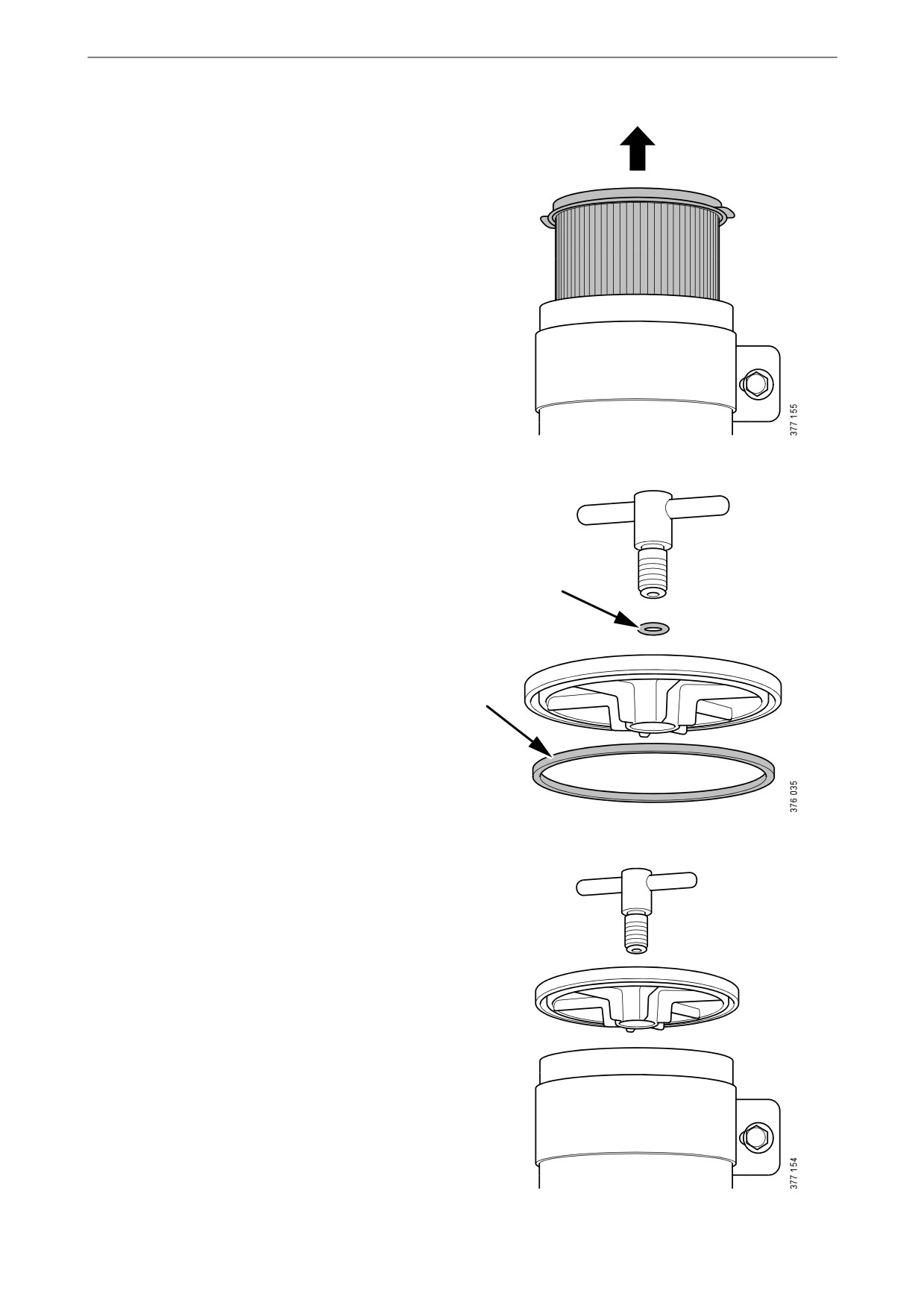
Fuel system
4. Remove the filter and fit the new filter.
5. Renew the O-rings in the cover.
6. Lubricate the O-rings with engine oil.
7. Fill the filter housing with clean fuel.
8. Fit the cover. Tighten the cover screw by
hand.
76

Fuel system
Bleeding the fuel system
Bleeding the fuel system using a suc-
tion tool
Tools
Designation
Illustration
Suction tool for fuel sys-
tem
Note:
Scania recommends bleeding the fuel system us-
ing suction tools rather than with a hand pump.
This is a quicker and simpler method, which en-
sures a complete bleeding.
Environment
Use a suitable container. The fuel collected must
be disposed of as specified in national and inter-
national laws and regulations.
1. Open the ventilating valve on the high pres-
sure pump and connect the suction tool to it.
See illustration. Start by wiping off the ven-
tilating valve.
2. Hold the suction tool straight and draw out at
least a full container of fuel.
3. Once the fuel coming out of the hose is free
of air bubbles, then bleeding is complete.
4. Close the ventilating valve on the high pres-
sure pump. Remove the hose and suction
tool.
5. Start the engine and check that no leakage
occurs.
77

Fuel system
Bleeding the fuel system using a
hand pump
Environment
Use a suitable container. The fuel collected must
be disposed of as specified in national and inter-
national laws and regulations.
Tightening torque
Ventilating valves
9 Nm (7 lb-ft)
1. Unscrew the hand pump handle.
2. Attach a clear plastic hose to the ventilating
valve on the prefilter.
3. Place the other end of the plastic hose in a
container that holds at least 5 litres
(1.3 US gallons).
4. Open the ventilating valve.
5. Pump with the hand pump until fuel without
air bubbles comes out.
6. Close the ventilating valve.
7. Connect the plastic hose to the ventilating
valve on the main filter.
8. Open the ventilating valve.
9. Pump with the hand pump until fuel without
air bubbles comes out.
10. Close the ventilating valve.
78
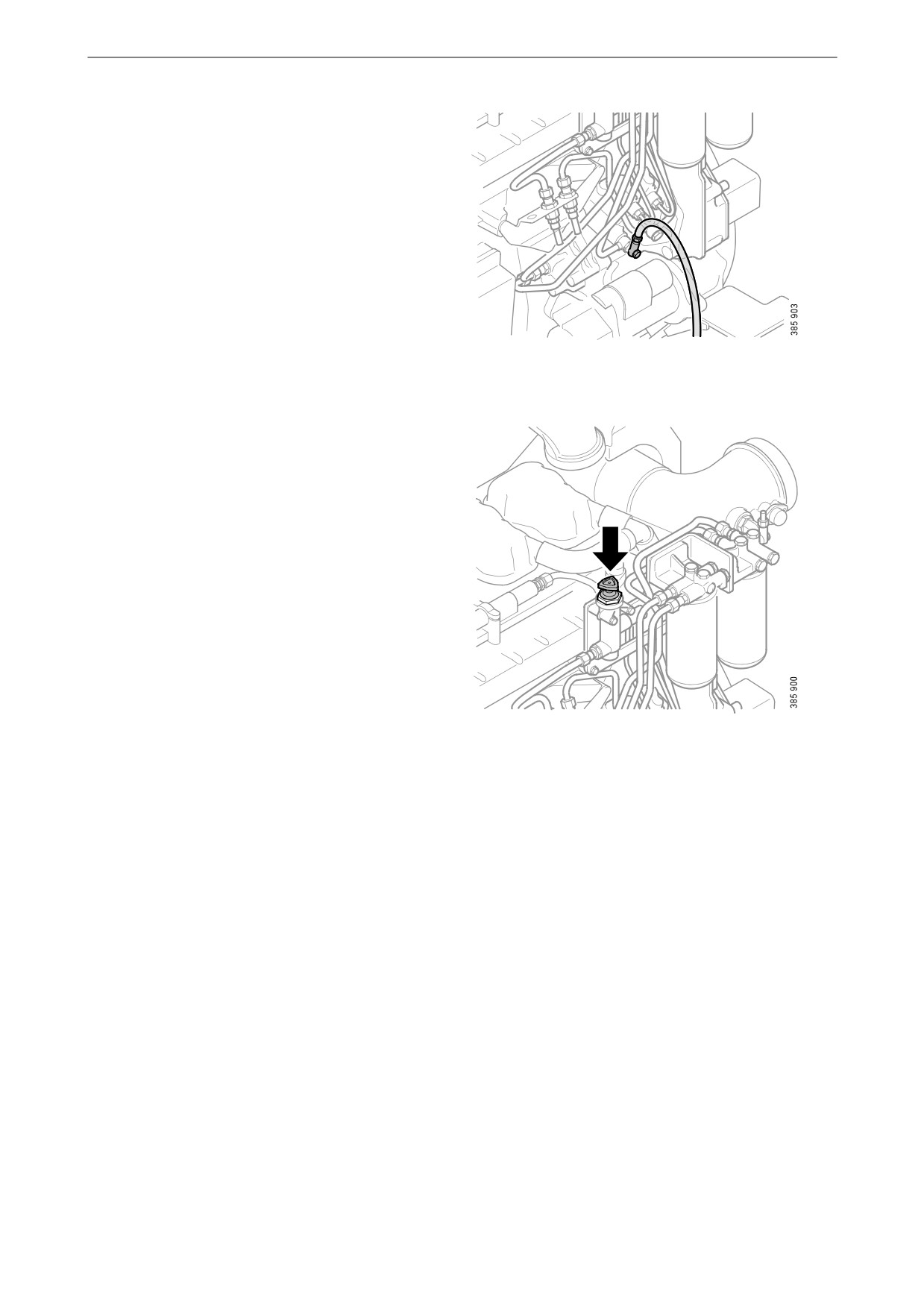
Fuel system
11. Connect the plastic hose to the ventilating
valve on the high pressure pump.
12. Open the ventilating valve.
13. Pump with the hand pump until fuel without
air bubbles comes out of the plastic hose. It
will take around 150 pump strokes.
14. Close the ventilating valve and screw the
hand pump handle downwards.
15. Start the engine. The engine should be easy
to start.
79